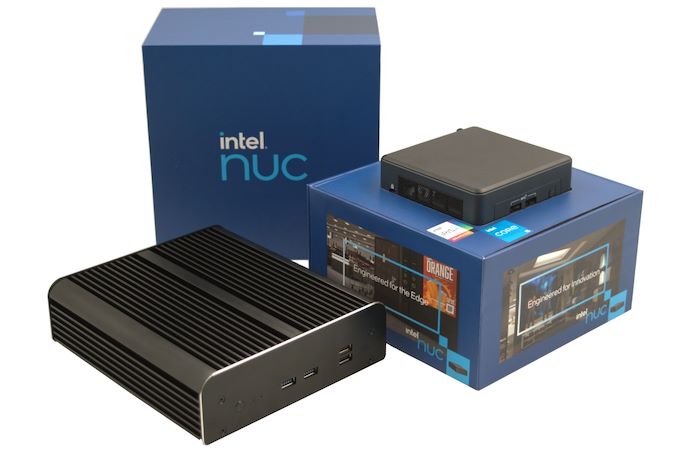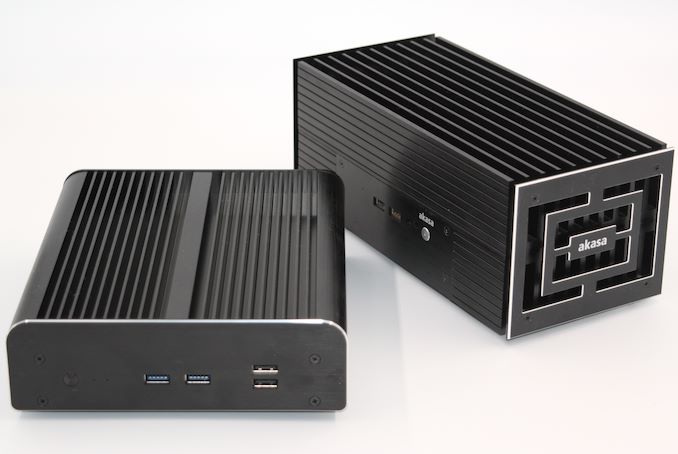Intel NUC11TNBi5 and Akasa Newton TN Fanless Case Review: Silencing the Tiger
by Ganesh T S on July 22, 2022 8:00 AM EST- Posted in
- Systems
- Intel
- Fanless
- HTPC
- NUC
- Passive Cooling
- UCFF
- Tiger Lake
- Akasa
Concluding Remarks
The Intel NUC11TNKi5 provided us with the opportunity to evaluate the Tiger Lake-U platform in a manner intended by Intel. Our previous evaluations involving the ASRock Industrial NUC BOX-1165G7 and Supermicro's SYS-E100-12T-H had the vendors' own take on configuring the system for specific markets. Intel's NUC Pro line targets the typical home / business PC user. Comparing Intel's default BIOS configuration with that of ASRock Industrial and Supermicro enabled us to understand the various options affecting the performance and efficiency of the system. It goes without saying that Intel's configuration of PL1 and PL2 limits, as well as configuration of C-states, provides the best balance between performance and energy consumption. As a mid-tier offering, the Core i5-1135G7-based NUC we looked at today completely blew away the competition in its price range. Multi-threaded workloads continue to remain a weakness when compared against high-end Renoir SKUs. At the lower TDPs, TGL-U has the distinct disadvantage of not having enough cores to go ahainst the top-end Renoir-based UCFF PCs. However, user experience continues to rely a lot on single-threaded performance. This is evidenced by the results of some of the key real-world benchmarks (such as web browsing) going in favor of Tiger Lake-U. In any case, the market will soon see Cezanne and Alder Lake-P dueling it out in the mini-PC space - so this just sets some context for those comparisons.
CPU performance is only one of the aspects to consider in computing systems meant for home and business use. In terms of connectivity and I/O options, the NUC11TNKi5 leaves other mini-PCs far behind. Dual Thunderbolt 4 ports mean that a host of high-performance connectivity options are just a dongle or dock away. While taking advantage of PCIe 4.0 in the UCFF form-factor is a bit of a challenge, it can nevertheless deliver benefits in specific storage-centric workloads.
Our experience with Akasa's Turing chassis for the Bean Canyon NUC had greatly raised our expectations when we were in the process of integrating the NUC11TNBi5 into the Akasa Newton TN fanless case. Our initial experience was very good - the case was actually quite cool to touch, and the package temperature was in the high 30s after the system was left idling at the desktop for more than 15 minutes. Most of our real-world benchmarks showed very little difference when compared against the actively-cooled version's results. Even in our stress test, the unit managed to escape throttling even though it brushed the junction temperature dangerously towards the end of the particularly strenuous workload component. Eventually, we did draft an extended version of the test to make the unit throttle. The thermal solution for the SSD also leaves a bit to be desired - the two thermal pads and the metal block aid in the SSD making contact with the metal chassis. However, it is not enough to prevent the SSD from touching 85C+ under sustained read-intensive workloads.
Our detailed tests revealed that the CPU throttling issue is not one of the chassis being able to handle the 28W PL1 settings - we were able to replicate the problem even with a 25W PL1. Rather, it appears that certain workloads create hotspots that the thermal design is not able to draw the heat away from sufficiently quickly. We saw that in one of the AIDA64 SST components, and also during the WPCStorage component of the SPECworkstation 3.1 benchmark. Likely causes for this issue include the thermal paste not having enough thermal conductivity (2.9 W/mK appears to be on the low end compared to what we usually see in thermal compounds used with desktop CPU coolers), or the use of aluminum against copper for the block transferring the heat away from the processor package. It could also be due to my own user error in doing a poor paste job. I have reached out to Akasa to check on this aspect. Overall, whether such CPU throttling cases arise frequently enough for it to matter in day to day usage as a home or business PC is up for debate, as the Newton TN otherwise maintains an excellent thermal profile.
A comparison of the Akasa Newton TN to the Turing is inevitable. They do have vastly different form-factors. However, the Turing definitely performed better in our thermal evaluation a couple of years back. One of the contributing factors in that could be sheer mass - the Turing with the board installed (and no 2.5" drive) clocks in at 2618g, while the Newton TN with a similar board configuration clocks in at just 1572g. The form-factor of the Turing also allows for more surface area for the heat to be dissipated. That said, there are a few advantages for the Newton TN - it can be VESA mounted, and it integrates additional I/O compared to the standard kit. In fact, the extra USB 2.0 ports come in handy for connecting various HID peripherals that do not require much bandwidth. Enabling the serial port functionality can also expand the target market for the chassis.
In terms of scope for improvement, one obvious aspect would be better thermal performance. Akasa can also attempt to add I/O diversity to the front panel with USB hub chips similar to what's done by Intel in their Extreme NUCs. Overall, the Akasa Newton TN is an effective solution to create a silent Tiger Canyon NUC while expanding the I/O functionality of the standard kit. Purely based on our experience with the original Akasa Turing / Bean Canyon NUC, we recommend the Akasa Turing TN if the form-factor or the VESA mounting capabilities or expanded I/O functionality are not a must for the deployment under consideration.












18 Comments
View All Comments
deporter - Friday, July 22, 2022 - link
Thanks for the review!Indeed, if you want to cool that kind of power without any throttling, you simply need a bigger mass of metal. Still, it's not so bad and probably good enough for most use cases.
deil - Monday, July 25, 2022 - link
A little sad its throttling, it's very close to sustaining it while new and clean, it might become choppy and slow soon, when tiny amount of dust will get in. especially in SFF, I prefer machines that don't go beyond 80'CyankeeDDL - Wednesday, July 27, 2022 - link
I use a laprop with Tiger Lake as my daily driver for work. Company policy is Intel-only.It is a hot mess, drains the battery and it is definitely not zippy. I have a 4800HS at home that runs circles around it.
74W at the wall. And it is half as fast as a 4800U in multithreaded apps. With TL Intel is not even in the same ballpark as AMD. Gen 12 seems a huge improvement. Perhaps Gen 13 will catch up.
ganeshts - Wednesday, July 27, 2022 - link
I am curious from a benchmarking suite perspective - what are the multi-threaded apps that you are using? CPU-based rendering like Cinebench etc., obviously benefits - but no one is seriously going to use a TGL-U system for that purpose. I do see MT performance benefiting compression and decompression using 7-Zip. Anything else?Calin - Thursday, July 28, 2022 - link
Corporate computers run a _lot_ of software that is not present on home computers. Also, their startup sequence is more complex due to the integration into Active Directory (adding extra startup steps).Not to mention that you might have a transparent VPN installed that send data through the company network, which slows down otherwise fast "internet" actions.
So, you're comparing apples and oranges.
TensorVortex - Friday, July 22, 2022 - link
Yah there are some router on aliexpress with i5 or i7 11th gen fanless that cost the same or cheaper than this. I bought one and was running it at 70C fanless, and a filter cap blown, and the high side mosfet also burnt through… bought new mosfet, contacted support to get the spec of the filter cap, apparently they are using L5V rating caps, no wonder it blowns in a fanless case…. I have replaced the cap with X5R cap, and running a fan to cool it down now…t.s - Friday, July 22, 2022 - link
For box that small, > 70 watt is insane.Ryan1981 - Saturday, July 23, 2022 - link
I have an Intel NUC 8 Rugged Kit NUC8CCHKR, I've tried the Zotac CI331 Nano, both fanless but not "noiseless"! I wanted these as a bedroom HTPC that I can leave on in the night for smart home purposes and the convenience of not having to wait till it's booted and ready to go but I ended up having to turn it off because while there is no fan noise, the electrical noise coming from these PC's is audible at night and disrupting my sleep. No major issue for me since it was a test but when I see this article claiming it is noiseless, I strongly suspect it is in fact not, and I'd feel it should be included in the testing. In fact I'd feel this is an underestimated topic to have bedroom appliances like clocks, phone chargers and nowadays smart lights etc. that do not make some form of electrical noise (speficially high pitched ones).ganeshts - Saturday, July 23, 2022 - link
I have observed the issue in a couple of fanless mini-PCs.. like the one reviewed here:https://www.anandtech.com/show/14157/zotac-zbox-ci...
I had observed this issue in some of the fanless Zotac PCs I had reviewed back in 2016 too. I think the problem actually may vary from sample to sample - I also reviewed the CI662 nano with pretty much the same board, but just a newer CPU - and that didn't have the problem.
It has probably got to do with some particular board component choice.
I am surprised about the Chaco Canyon, though. Usually, Intel's board components are top-notch.
abufrejoval - Saturday, July 23, 2022 - link
I got tons of equipment in the room where I also sleep.And I remember being bothered by a high pitched noise when things quietened down at night, that was hard to pinpoint. I tried using a spectroscope app on the smartphone to identify where the high pitch was coming from, too. I wound up really ripping out everything connected to the power lines, but no luck.
Eventually it dawned on me that I have tinnitus...